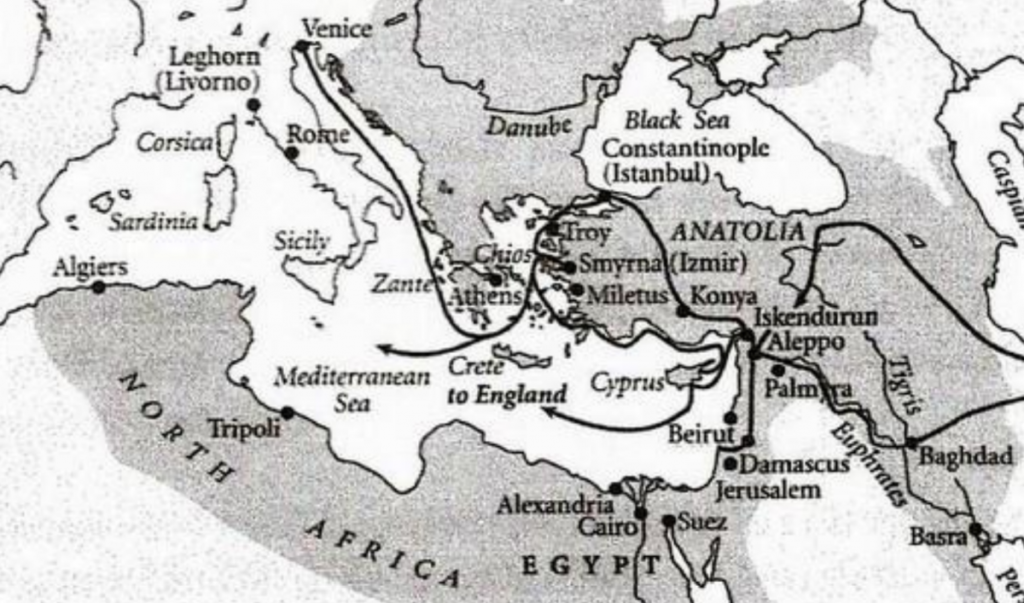Turkey Oilstones (or Cretan Oilstones) are a type of Flint stone which has been mined from Elounda mountain since the days of Ancient Greece and is the oldest quarry in the world even having been mentioned in the Iliad. These stones go by many different names including Cretan Oilstone, Turkish Oilstone, Turkey Stone, Levant Stone, Candia Stone, Pierre Du Levant, Pierre Du L’est, and Ladakona. These stones are bluish gray in color with frequent white spots, freckling, fractures, and streaks throughout the stones structure. Stones that have this look and are sold as Turkey stones actually originated from the eastern quarry on the Island of Crete. The first descriptoin of the Cretan stone comes from Pliny the Elder who refers to the Creatn stones as being the best available. The likely origin of the word Turkey Oilstone for the Cretan stock comes from the stone having been shipped to mainland Turkey before being resold, leading to it internationally being referred to as the Turkey stone.
To further complicate the matte, the island of Crete was part of the Ottomon empire until 1898. Trade with the Ottoman Empire by most Western nations was done through the Levant Company (Turkey Company) who were often referred to as Turkey Merchants or the Turkish. It is very likely the name was formed through this association.
Turkey Oilstone / Cretan Oilstone Geological Composition
Their geological structure is difficult to classify, having been called both dolomite and novaculite in the past. Griswold classifies them as a flint siliceous limestone as the most accurate form of stone to classify them as. Most are made from 70-90% silica – in the form of microcrystalline quartz – intermingled with 30% lime, clay or iron. As with many natural whetstones, the silica content is originating from the silica shales of dead planktonic organisms (radiolarians and diatoms) which were mixed with sedimentary matter, compressed, and metamorphically altered by geological events due the middle Precambrian period. The stone deposits often have fossils in the form of sponge spicules and radiolarians, as well as detritus of plant origin which create the freckling and patterns within its structure. The layers of stone there are 4 to 15 cm thick and vein between calcareous minerals. Specific gravity tends to be in in the 2.6-2.73 range.
Turkey Oilstone / Cretan Oilstone Use
When oil is added the stone turns a very dark grey/brown/black hue with it being almost impossible to fully remove the oil afterwards. The whiter stones will cut faster but be coarser while the darker stones will cut slower but be a bit finer. This coloration is impossible to tell once oil has been added to the stone as they all turn dark. Cretan stones range in the analogous 6-8k range and are very fast cutting stones. Despite the name, the stone is perfectly fine being used with water so long as it has never been oiled before. However, the stone does benefit from the use of oil in two ways, with less pressure on the blade to create a finer edge or with more pressure on the blade to allow the stone to cut longer (by lubricating the abrasive particles and avoiding excess friction wear). If you are using water instead of oil, the stone will need to have its surface refreshed more often and will be more aggressive right after doing so. Cretan / Turkey Oilstones can have a tendency to break along the lime lines which run through it so care must be taken.
The stones were (and are) very popular for being one of the faster cutting and easily accessible natural stones available. Cretan / Turkey Oilstones are probably in the top 3 best cutting “fine” natural stones along with Washitas and Coticules. The commercial proliferation of the Washita largely ended the reign of the Cretan / Turkey Oilstone as being the premiere affordable stone in its class (Coticules always being pricey in comparison). In the modern day, all of them are outdone by synthetic stones (if pure speed is what you are after) but the Creatn / Turkey Oilstone still remains affordable, accessible (still mined), and as rich with history as it ever was.
Non-Cretan Turkey Oilstones Versions
There is a stone that comes from the Bolu regions in Turkey that was also sold as a Turkey stone. These stones were far more homogonous than the Cretan origin stones and usually darker, though lighter varieties did exist. These stones are not common and little information about them is known beyond their region of origin. Largely though, all historic and current “Turkish Oilstones” are actually from the Elounda mountain in Crete.
